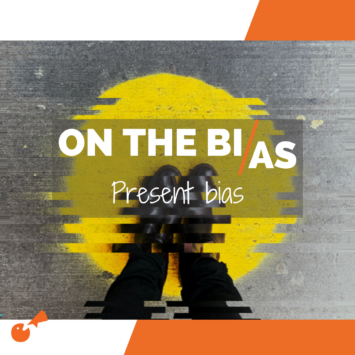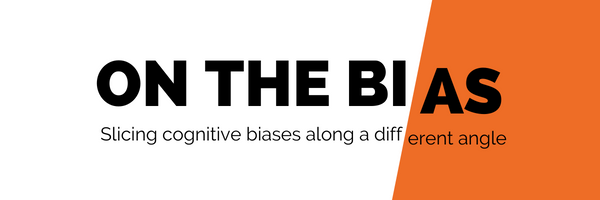
ON THE BIAS: Present Bias
Welcome to the blog series, ON THE BIAS.
In this series, we look at the cognitive biases we have as humans and how they impact our behavior change efforts. Catch up with the previous two posts on the IKEA effect and the mere exposure effect.

A story: assigning work to my future self
It’s Friday afternoon, and I’m having that reality-check moment that the four things left on my to-do list are not going to get done this week.
Ugh.
Yet one of those to-do’s should really get “to-done” before Monday rolls around, so I assign it to myself to complete on Sunday.
After all, I don’t have any plans on Sunday. It will be a slow day with no emails coming in, and I can get it done in 2 hours and then cross it off my list.
I close out my Friday feeling good that I have a plan in place.
Then, Sunday morning rolls around, and I get a reminder on my phone to complete the task I assigned myself.
My not-so-inner monologue goes something like this,
“WTF?!?!? It’s SUNDAY! I don’t wanna work today. Who’s the jerk who assigned this to me on the weekend??!?! There’s no way I’m doing this today. Weekends are MY time to rest and recover. I’ll do this tomorrow instead.”
Then the work block gets deleted from the calendar, officially pushing the assignment to Monday.
What’s happening here?
Assigning the task to the weekend felt like the responsible and rational choice to my Friday self, even though it breaks my rule of not assigning work to the weekends.
This is because my Friday self was currently in “work mode,” and completing another task in two days didn’t feel like a big deal.
But my Friday self didn’t consider how my future self was going to feel about working on the weekend. I couldn’t empathize with the fact that Sunday Brooke likes to focus on non-work activities.
In essence, I fell victim to the present bias. This is when we make decisions today, at the moment, that may not benefit our future selves.
ON THE BIAS: When deciding how to spend our time and resources, we tend to make short-term decisions that don’t align with our future aspirations.
This occurs because we have a difficult time empathizing with our future selves.
This feels surprising, yet studies have shown that our future self feels like a stranger to us rather than simply feeling like an older version of who we are today.
Present bias can play out in the near term, like opting for indulgent foods in the moment that doesn’t align with our health goals.
It can also play out on a longer-term basis, like not saving money today for future retirement needs.
Bringing the bias home: What decisions are you making today, with your present self, that will have implications for your future self?
Consider if you are making decisions that benefit future you and if there is more you can do to set yourself up for success (success being defined on your own terms).
If there are areas where you would like to make better decisions today to help develop positive, longer-term habits, then try empathy activities.
Close your eyes and visualize yourself in two days, two months, two years, or two decades. Aim to make a compassionate connection with that future version of you and what you wish you’d done previously.
“It may not be problematic to think about our future selves as if they are other people, as long as we see them as people with whom we have a close, emotionally bonded relationship — for those are the sorts of relationships that inspire us to make sacrifices.”
How this bias can help or hurt our behavior change programs
For this post, we’re going to start with how this bias can hurt our behavior change efforts before we look at the bright side.
HOW IT CAN HURT
When the COVID-19 pandemic began, many people drew the analogy between the lack of attention given to zoonotic disease risks and the lack of action on climate change. It’s an observation that society seems to only care about an issue once it’s on our doorstep (and, therefore, too late to prevent it from happening).
This is a frustration we feel about why people aren’t taking action today to benefit the planet tomorrow, which is a result of the present bias.
This bias hurts efforts around routine, cyclical behaviors like reducing food waste, lowering energy and water consumption at home, and composting since the audience is always susceptible to making decisions that benefit them most in the moment (like turning up the heat when feeling cold).
We see this bias hurting our efforts the most around the need to make significant changes today to benefit a future planet tomorrow.
Solar panels are an example of this. It requires a significant financial investment at the start for a payoff that comes later down the road. And if someone decides to move before that payoff occurs, they’ve benefitted a future someone else (which is even harder to empathize with than your future self).
It may not feel like present bias has anything helpful to contribute to our efforts, but there are opportunities to help our audience make better decisions today.
HOW IT HELPS
The good news is that an increasing number of people want to take action today, which puts present bias more in our corner. However, audiences will still need help making the best decisions now and sticking with their goals as present bias creeps in regularly.
Pledges can be a helpful tactic here, especially for those cyclical behaviors. For example, we can ask our audience to make a commitment today to reduce food waste at home moving forward.
To help overcome the ongoing risk of impulse purchases at the grocery store, we can equip the audience with tools (e.g., meal planners, waste-less recipes, food storage tips) and provide a consistent stream of reminders to help them follow through on their commitments.
Creating near-term tangible benefits can be helpful for actions that require an upfront investment with delayed benefits, like solar panels. Those benefits may take the form of a rebate, a discount on the cost of the panels, or a free bonus gift.
The near-term reward helps bridge the gap between the present moment and future benefits.
We can also support our audiences in making better decisions today by helping them visualize a better future for themselves and for the planet.
Tapping into feelings of aspiration and hope for the future can lead to making commitments and plans for how to achieve those desires.
“Empathizing with our future self is inherently difficult, but incredibly important. Visualization may be key. While art may be a great way to connect with future others, it’s through visualizing our future selves that we gain a greater appreciation for the long-term impact of our present-day decision-making.”
A NOTE OF CAUTION
Although we can use visualization techniques to create aspiration and empathy for our future selves, present bias means humans are still pretty bad at predicting how we will feel in those future moments.
Here is a funny research tale about this: making a present-day decision to receive ice cream every day for the next 30 days.
From Empathisizing with Future Selves:
“Daniel Kahneman provided an exploration of this exact scenario, and if you’re like the volunteers in his study, you’d have a very optimistic prediction of how happy this would make you. Everyone predicted that their enjoyment of the ice cream would grow each day, and by day 30, they would be in ice cream bliss.
Halfway through, participants were begging to drop out of the study, and those who did make it to the end felt miserable. The idea of eating ice cream every day seems great. But the actual impact on our future state of happiness? Not so much.”
Biases that are closely related to this example is hyperbolic discounting and projection bias. You can learn more about present bias here.
I hope you enjoyed learning about one of the many ways we’re wired.


